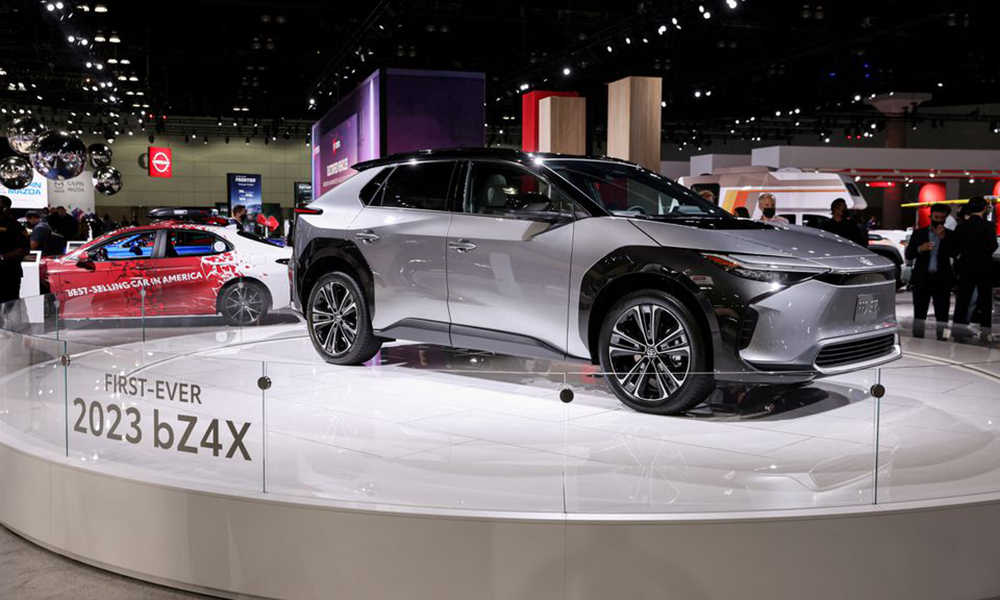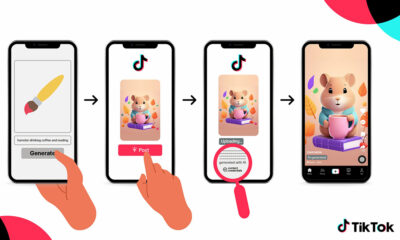Science & Technology
Toyota rolls out first battery electric car in cautious debut as rivals go full-throttle

Toyota Motor Corp (7203.T) rolls out its first mass-produced battery electric car in Japan on Thursday for lease only, a strategy the automaker says will help ease driver concerns about battery life and resale value but has raised analysts’ eyebrows.
Gasoline-electric hybrid models remain far more popular in Toyota’s home market than electric vehicles (EVs), which accounted for just 1% of the passenger cars sold in Japan last year, according to industry data. Still, the market is growing fast and foreign automakers including Tesla Inc (TSLA.O) are making visible inroads on the streets of cities such as Tokyo.
Bundling insurance, repair costs and a battery warranty into the deal, Toyota will lease the bZ4X sport utility vehicles (SUV) at the equivalent of $39,000 for the first four years. Cancelling in the first 48 months will mean an additional fee.
While EV acceptance has been slow in Japan, that will change, and Toyota could risk losing market share by focusing on a model of leasing rather than purchasing, said CLSA analyst Christopher Richter.
“Anything you are doing that’s making it harder to buy is maybe not a good thing,” he said.
“It’s a strategy I am not that fond of. It does signal that Toyota is taking the home market a little bit for granted.”
Toyota said in December it would commit 8 trillion yen ($62 billion) to electrify its cars by 2030.
Toyota aims to lease 5,000 of the SUVs in the current financial year – around the same amount of EVs that analysts estimate Tesla sold in Japan last year.
The automaker plans to start selling the bZ4X in other markets later this year, and pre-orders have already started in some European countries.
Toyota has not decided when it will start selling the cars in Japan, a spokesperson said.
‘DISPEL ANXIETY’
EVs became popular in Europe through lease programmes offered by employers and Toyota may be trying a similar tack to popularise electric cars, said Seiji Sugiura, a senior analyst at Tokai Tokyo Research Institute.
First-time customers are concerned about battery life and the potential fall in the trade-in value over time, said Shinya Kotera, president of KINTO, the Toyota unit offering the leases.
“It’s our role to dispel anxiety” toward EVs, he said.
Imports of battery EVs jumped almost three times to a record 8,610 vehicles in 2021, according to industry data. Analysts estimate roughly 60% of those were Teslas.
Still, Japanese automakers remain cautious about switching into the all-electric lane.
Toyota pioneered the hybrid more than two decades ago and retains big ambitions for both hybrids and hydrogen-powered vehicles, even as it is investing more to boost its battery EV line-up.
Rival Nissan Motor Co (7201.T) pioneered mass-market EVs with the Leaf in 2010 but will launch only its second battery EV model, the Ariya SUV, also on Thursday. The Ariya will be sold for the equivalent of $41,500, not including a government subsidy.
Honda Motor Co (7267.T) in April laid out a target to roll out 30 electric vehicle models globally by 2030.
Science & Technology
TikTok to label AI-generated content from OpenAI and elsewhere

TikTok plans to start labelling images and video uploaded to its video-sharing service that have been generated using artificial intelligence, it said on Thursday, using a digital watermark known as Content Credentials, Reuters reported.
Researchers have expressed concern that AI-generated content could be used to interfere with U.S. elections this fall, and TikTok was already among a group of 20 tech companies that earlier this year signed an accord pledging to fight it.
The company already labels AI-generated content made with tools inside the app, but the latest move would apply a label to videos and images generated outside of the service.
“We also have policies that prohibit realistic AI that is not labeled, so if realistic AI (generated contents) appears on the platform, then we will remove it as violating our community guidelines,” Adam Presser, head of operations and trust and safety at TikTok, said in an interview.
The Content Credentials technology was spearheaded by the Coalition for Content Provenance and Authenticity, a group co-founded by Adobe (ADBE.O), opens new tab, Microsoft (MSFT.O), opens new tab and others, but is open for other companies to use, read the report.
It has already been adopted by the likes of ChatGPT creator OpenAI.
YouTube, owned by Alphabet’s (GOOGL.O), opens new tab Google, and Meta Platforms (META.O), opens new tab, which owns Instagram and Facebook, have also said they plan to use Content Credentials.
For the system to work, both the maker of the generative AI tool used to make content and the platform used to distribute the contents must both agree to use the industry standard.
When a person uses OpenAI’s Dall-E tool to generate an image, for example, OpenAI attaches a watermark to the resulting image and adds data to the file that can later indicate whether it has been tampered with, Reuters reported.
If that marked image is then uploaded to TikTok, it will be automatically labeled as AI-generated.
TikTok, which is owned by China’s ByteDance, has 170 million users in the U.S., which recently passed a law requiring ByteDance to divest TikTok or face a ban. TikTok and ByteDance have sued to block the law, arguing it violates the First Amendment.
Science & Technology
China launches historic mission to retrieve samples from far side of the moon

China on Friday launched an uncrewed spacecraft on a nearly two-month mission to retrieve rocks and soil from the far side of the moon, the first country to make such an ambitious attempt.
The Long March-5, China’s largest rocket, blasted off at 5:27 p.m. Beijing time (0927 GMT) from Wenchang Space Launch Center on the southern island of Hainan with the more than 8 metric ton Chang’e-6 probe.
Chang’e-6 is tasked with landing in the South Pole-Aitken Basin on the far side of the moon, which perpetually faces away from the Earth, after which it will retrieve and return samples.
The launch marks another milestone in China’s lunar and space exploration programme.
“It is a bit of a mystery to us how China has been able to develop such an ambitious and successful programme in such a short time,” said Pierre-Yves Meslin, a French researcher working on one of the scientific objectives of the Chang’e-6 mission.
In 2018, Chang’e-4 gave China its first unmanned moon landing, also on the far side. In 2020, Chang’e-5 marked the first time humans retrieved lunar samples in 44 years, and Chang’e-6 could make China the first country to retrieve samples from the moon’s “hidden” side.
FOREIGN PAYLOADS
The launch was attended by scientists, diplomats and space agency officials from France, Italy, Pakistan, and the European Space Agency, all of which have moon-studying payloads aboard Chang’e-6.
But no U.S. organisations applied to get a payload spot, according to Ge Ping, deputy director of the China National Space Administration’s (CNSA) Lunar Exploration and Space Program.
China is banned by U.S. law from any collaboration with the U.S. space agency, NASA.
“The far side of the moon has a mystique perhaps because we literally can’t see it, we have never seen it apart from with robotic probes or the very few number of humans that have been around the other side,” said Neil Melville-Kenney, a technical officer at ESA working with Chinese researchers on one of the Chang’e-6 payloads.
After the probe separates from the rocket, it will take four to five days to reach the moon’s orbit. In early June a few weeks later, it will land.
Once on the moon, the probe will spend two days digging up 2 kilogrammes (4.4 lb) of samples before returning to Earth, where it is expected to land in Inner Mongolia.
The window for the probe to collect samples on the far side is 14 hours, compared to 21 hours for the near side.
The samples brought back by Chang’e-5 allowed Chinese scientists to uncover new details about the moon, including more accurately dating the timespan of volcanic activity on the moon, as well as a new mineral.
Ge said the scientific value of Chang’e-6 lay in the geological age of the South Pole-Aitken Basin, which his team estimated was about 4 billion years, much older than the samples previously brought back by the Soviet Union and the United States, which were about 3 billion years old, as well as the 2-billion-year-old samples from Chang’e-5.
LUNAR BASE
Besides uncovering new information about the celestial body closest to Earth, Chang’e-6 is part of a long-term project to build a permanent research station on the moon: the China and Russia-led International Lunar Research Station (ILRS).
The construction of such a station would provide an outpost for China and its partners to pursue deep space exploration.
“We know that the moon may have resources that could become useful in the future, so the European Space Agency, NASA, the Chinese agency and others around the world are going to the moon,” said James Carpenter, head of the ESA’s lunar science office.
“Part of the rationale is to understand those resources,” Carpenter said.
Wu Weiren, chief designer of the Chinese Lunar Exploration Project, speaking at the 2024 China Space Conference last month, said a “basic model” of the ILRS would be built by 2035.
(Reuters)
Science & Technology
Apple set for big sales decline as investors await AI in iPhones

Apple’s (AAPL.O), opens new tab plan to add generative AI to its iPhones and revive sagging sales in the crucial Chinese market will be in focus on Thursday, when the tech giant is expected to report its biggest quarterly revenue decline in more than a year, Reuters reported.
Long considered a must-own stock on Wall Street, Apple shares have underperformed other Big Tech companies in recent months, falling more than 10% this year as fears mount about its slow roll-out of artificial intelligence services and as a resurgent Huawei (HWT.UL) takes market share in China.
Analysts on average see iPhone sales, which account for about half of Apple’s revenue, falling 10.4% in the first three months of 2024, according to LSEG. That drop would be the steepest in more than three years.
The year-ago iPhone revenue that the 10.4% iPhone sales drop is measured against was unusually high as Apple satisfied pent-up demand after the COVID pandemic, company executives previously noted.
At least $5 billion of the $51.3 billion in iPhone sales a year ago was essentially catching up from disruptions in the December 2022 quarter when COVID lockdowns in China hampered iPhone production, executives said.
Even with that factored in, Wall Street expects a slight decline in iPhone sales, and analysts estimate Apple’s total revenue declined 5% in its fiscal second quarter ended in March. That would be Apple’s biggest revenue decline since the December 2022 quarter, when revenue fell 5.5%, read the report.
Apple earlier this year lost the crown of the world’s most valuable company to Microsoft (MSFT.O), opens new tab. Its market value stands at $2.68 trillion after the share price declined 11.24% so far this year.
Weak revenue and falling shares have pressured Apple to spruce up its flagship device after years without major upgrades.
The company is in talks with OpenAI and Alphabet-owned Google to add genAI features for the iPhone that could be unveiled at what is expected to be its biggest-ever annual developer conference in June, Bloomberg News has reported.
According to Reuters analysts believe such an AI integration could drive demand for the next iPhone series, expected to be announced in the fall.
While executives at Microsoft, Alphabet (GOOGL.O), opens new tab, Meta Platforms (META.O), opens new tab and other major technology firms have talked up their AI strategies on quarterly conference calls in recent months, Apple CEO Tim Cook has discussed his plans for the emerging technology much less.
Adding AI features to iPhones could also help Apple to compete better with Huawei and Samsung Electronics (005930.KS), opens new tab, which reclaimed the title of the world’s top smartphone vendor from Apple this year, driven by demand for the AI features in its Galaxy S24 smartphones.
“Replacement cycle tailwinds and incremental generative AI features set up Apple well for a strong iPhone 16 cycle,” Bernstein analyst Toni Sacconaghi said this week as he upgraded the company’s shares to “outperform” from “market-perform.”
“We believe prevailing weakness in China is more cyclical than structural, and note historically Apple’s China business has exhibited much higher volatility than Apple overall, given its very feature-sensitive installed base.”
Thursday’s earnings will also be watched closely for updates on the company’s stock buyback plan and the Vision Pro, Apple’s first major product in years that hit the shelves in February.
After initial enthusiasm, there have been signs that demand slowed for the $3,500 device, with an analyst saying this month that Apple has pulled back its production estimates for the mixed-reality headset.
The rest of the company’s hardware business is also reeling from soft demand, with iPads and Mac sales expected to fall 11.4% and 4.3%, respectively, in the March quarter, Reuters reported.
Apple has signaled it is sharpening its focus on the devices, which have also been hobbled by a lack of major upgrades.
At an Apple event this month, a revamped iPad line-up is expected to be unveiled and media reports have said that it plans to update every Mac model with faster, AI-focused M4 processors.
The services business, which includes App Store and subscription services such as Apple TV, is expected to remain a bright spot with revenue growth of 7.7%.
Apple shares closed down 0.6% at $169.30 on Wednesday.
-

 Business4 days ago
Business4 days agoAfghanistan’s Turkey-bound goods via rail cross Tehran
-

 Latest News4 days ago
Latest News4 days agoOIC summit urges IEA to respect girls’ right to education
-

 Business4 days ago
Business4 days agoTurkmenistan’s industrialists keen to buy Herat-made construction material
-

 Sport4 days ago
Sport4 days agoAbu Muslim humiliate Maiwand with 9-1 win; Sohrab Afghan scores 5 goals
-

 World4 days ago
World4 days agoIsraeli authorities raid Al Jazeera after shutdown order
-

 Latest News4 days ago
Latest News4 days agoIranian official: Only vulnerable points of Afghanistan’s border will be walled and fenced
-

 World4 days ago
World4 days agoHamas says it accepts ceasefire proposal of Egypt, Qatar
-

 Latest News4 days ago
Latest News4 days agoUNHRC approves national human rights report on Afghanistan
























